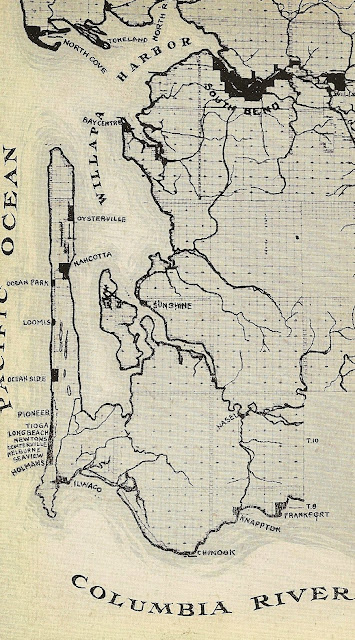 |
Schooner RANGER
212407
Drawing courtesy of B. L. Brown.
Click to enlarge. |
Auxiliary Schooner (Yacht) RANGER
O.N. 212407
Designed by Thomas D. Bowes and Charles D. Mower,
Naval Architects of Philadelphia.
Built by Henry B. Burger, Jr. Manitowoc, WI, in 1914.
The owner, R. B. Brown of Milwaukee, WI, and Deer Harbor, WA.
Dimensions listed on the Tonnage Admeasurement papers filed with the Dept of Commerce & Labor,
27 June 1914:
Gross tonnage: 48
Net tonnage: 44
Reg. Length: 67'
Tonnage Length: 74.8'
L. O. A: 77.6'
Reg. Beam: 17.2'
Reg. Depth: 8.2' (centerboard)
Spoon Bow, Square Transom
HP: 50-HP Wolverine.
There is some incorrect information on the web regarding this vessel, including entries on the Woodenboat Forum; the data listed above is newly archived information, thanks to the helpful staff from the National Archives, Chicago.
After good times sailing the Great Lakes area, The RANGER sailed from Milwaukee, Wisconsin in 1939, with the owner and a crew of seven friends, through the Chicago drainage canal to meet the Illinois River, down the Mississippi River, across the Gulf of Mexico to Kingston, Jamaica, then to Cristobal, to head for a transit of the Panama Canal, up the rugged west coast, safely to her new anchorage in front of "Arcady", the home of the skipper in Deer Harbor, WA. A total of 8,500 miles.
 |
A segment of RANGER's
course from the home state
of Wisconsin to the Gulf.
Ten days were spent at a shipyard
in the heat of New Orleans.
Map courtesy of Wikipedia. |
 |
RANGER had a three-week layover
at Kingston, Jamaica.
Something about tasting the rum and
welcoming aboard an engine mechanic.
|
Those on board for the long passage were the owner/skipper "R. B." Brown, "Doc" Earl Cilly, Bill Steinike, Jake DeBoer, radioman, Mr. Curtis, Johnny Findorff, cabin boy, Eddy Price, cook, and seaman Lew Dodd of Orcas Island. The last two mentioned each wrote separate accounts of the trip.
With some good fortune, Lew Dodd's descriptive article was published in Pacific Motor Boat, January 1940. His name will be familiar to some readers from and interested in San Juan County life. Lew and his wife were known for building and retiring to a small, delightful cabin on Yellow Island in c. 1947, another intriguing story. ("Their" island is now owned by the Nature Conservancy.) Lew's 9-page article is included on this site as a "Page" and can be located on the home page.
WW II:
RANGER was used by the US Coast Guard in the waters of Washington State during the war. Through operator error, the vessel was wrecked on the rocks of San Juan Island, meaning her keel was broken. She was stuffed with empty barrels to keep her afloat for a passage to a shipyard. The barrels thrashed around the interior to demolish the fine woodwork. It is not clear in what condition she was in when released to the next private party.
1944:
H. M. Fierrell buys RANGER from the original owner, R. B. Brown, now of Deer Harbor, WA.
1949, Summer:
Ruth Brown chartered RANGER with skipper/owner, H. M. Fierrell, for her programs at Westward Ho Camp, Orcas Island, to substitute for WESTWARD HO, off sailing the TransPac Race.
1949, Winter:
 |
RANGER
(212407)
owned by H. M. Fierrell in 1949.
Preparing for an adventure trip to the South Pacific,
Location: Queen City Yacht Club, Seattle, WA.
Original photo from the archives of the Saltwater People Historical Society©
|
"Within 2 weeks, H. M. Fierrell, a 40-year-old Navy veteran, plans to head his schooner-rigged RANGER for South Pacific waters.
Fierrell has been interviewing crew for an expense-sharing cruise. "You have to be sure to get the right sort of men for a cruise like this," he declared.
So far, he has lined up four men; he said he could take six more crew members. He figured it would cost each man about $500 for the six-month cruise.
Fierrell is living aboard the RANGER at the Queen City Yacht Club until he sails for the South Pacific. He plans to return in six months to spend the summer running charter cruises in Puget Sound as he did last summer."
This text in quotes, from The Seattle Times, 6 December 1949.
1952:
From a Seattle Times report of 14 May 1952, we learn that skipper/owner, H. M. Fierrell, and his wife were rescued at sea with 8 others from their schooner, ELOISE, c. 22 miles south of the Golden Gate, CA, bound for an adventure trip to the South Seas. The USCG EWING reportedly towed the distressed, 1915-built schooner to San Francisco. The article states that Fierrell did not make it to the South Pacific in his previous schooner, RANGER.
2013:
We hear from Panama correspondents that RANGER is being restored in hopes she will be sailing for her centennial birthday in 2014.








